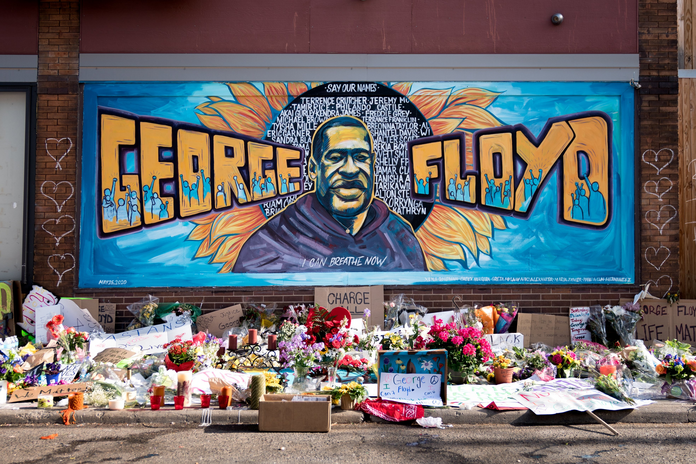On May 25, 2020, in Minneapolis, MN, George Floyd went to a grocery store named Cup Foods to buy a pack of cigarettes. An employee at the store believed that the $20 bill Floyd used was counterfeit, so he reported it to the police. According to BBC News, when the employee called 911, he told the operator that he demanded that Floyd give him the cigarettes, and then went on to say, “he [Floyd] doesn’t want to do that.” The employee also told the operator that Floyd didn’t appear to be sober. After this call, two police officers arrived, J Alexander Kueng and Thomas Lane. When they arrived, Floyd was sitting in a car, parked around the corner, with two other people. The police officers approached the car, and one drew his gun. Floyd was pulled out of the car, by Thomas Lane, the officer who had his gun drawn, and it is said that Floyd actively resisted being handcuffed but was compliant once handcuffed, and he was told he was being arrested for “passing counterfeit currency.” When the officers went to put Floyd in their squad car, a struggle, reportedly, began. According to the report, Floyd stiffened up and fell on the ground and told them he was claustrophobic. During the struggle to get Floyd into the squad car, (at this point he was off the ground) more officers, Derek Chauvin and Tou Thao, arrived. Floyd was almost in the squad car when Chauvin pulled Floyd away from the squad car and onto the street. At this point, Floyd was laying on the ground with his hands cuffed behind his back and his face on the ground. Chauvin placed one knee on Floyd’s neck and the other on his upper back, while Kueng and Lane restrained the lower part of his body and Thao stood there. This is when bystanders began to record. Derek Chauvin had his knee on George Floyd’s neck for nine minutes and twenty-nine seconds, which is something everyone has since learned in the midst of the trial, for it was originally said to be eight minutes and twenty-six seconds. Floyd lied motionless and unresponsive for at least two minutes before Chauvin removed his knee. After being put on the gurney, Floyd was taken to Hennepin County Medical Center where he died an hour later.
This tragic event was a catalyst for many protests nationwide, and all of the officers involved were fired. The officers are also facing criminal charges. According to WBIR, Chauvin faces unintentional second-degree murder, second-degree manslaughter and third-degree murder ,and the other three officers face the aiding and abetting of unintentional second-degree murder and the aiding and abetting of second-degree manslaughter. They were originally supposed to have a joint trial, but they have been separated. Chauvin’s trial is now and the trial of the other two officers is scheduled for August.
Derek Chauvin’s trial started on March 29, 2021. The judge over this case is Hennepin County District Judge Peter Cahill. There are twelve jurors, two alternates, and according to The Mercury News, the demographic of the jury is nine women and five men; eight are white, four are black and two are mixed race. The prosecution includes State Attorney General Keith Ellison, Assistant Attorney General Matthew Frank, Steven Schleicher, Jerry Blackwell and Neal Katyal. Chauvin’s legal defense is being covered by the Minnesota Police and Peace Officers Association, and the lawyer working one the defense is Eric Nelson. Chauvin has pleaded not guilty to all charges, including second-degree unintentional murder, third-degree murder and second-degree manslaughter.
This makes week three of the trial, but in case you’ve been missing it, I’ll give key things from each week.
- Week 1
-
The prosecution and defense made their opening statements. It was emphasized in the prosecution’s opening that Chauvin had his knee on Floyd’s neck for nine minutes and twenty-nine seconds. In their statement, the prosecution also urged the jurors to pay attention to what is in front of them by saying “believe your eyes, that it’s homicide — it’s murder.” The defense urged the jurors to pay attention to all details and evidence outside of the video. Nelson is quoted in saying the case “is clearly more than about 9 minutes and 29 seconds.”
The prosecution had nineteen witnesses that took the stand. Some of the key witnesses included Jena Lee Scurry, Minneapolis 911 Dispatcher, Donald Wynn Williams II, witness and professional fighter, Christopher Martin, Cup Foods employee, Courteney Ross, George Floyd’s girlfriend, Seth Zachary Bravinder, Hennepin County paramedic, Minneapolis police Sgt. David Pleoger, and Minneapolis police Lt. Richard Zimmerman. There were many emotional and light shedding testimonies. In Scurry’s testimony, she recounted being able to see what happened from her office from street cameras, and feeling that something wasn’t right. She had such a strong feeling about this that she called their supervisor to report the excessive force. Williams testified that, because of his background, he recognized what Chauvin was doing as the “blood choke,” which is a move that restricts blood circulation. Martin, the employee that took the twenty dollar bill, expressed his guilt in saying “If I had just not taken the bill, this could’ve been avoided.” Ross, Floyd’s girlfriend, addressed the fact that they both struggled with drug addiction. She says they both became addicted to opioids due to having chronic pain, hers in her neck and Floyd’s in his back. Bravinder, paramedic, testified to the fact that Floyd was in asystole, which is a form of cardiac arrest where the heart is not pumping blood. Pleoger testified that Chauvin did not immediately give him details about the amount of force he used or how long he used it; he found out when he received the call from Scurry, the 911 dispatcher. And, Zimmerman testified that the force that Chauvin used was “totally unnecessary”.” According to Kare 11, Zimmerman also said, “Once you handcuff a person you need to get them out of the prone position as quickly as possible, because it restricts their breathing.”
- Week 2
-
During this week, there were nineteen more of the prosecution’s witnesses that testified. A few of the witnesses included were Chief Medaria Arradondo, Inspector Katie Blackwell, the Fifth Precinct Inspector for the Minneapolis Police Department, Lt. Johnny Mercil, a use of force trainer with Minneapolis Police Department, Officer Nicole Mackenzie, a medical support coordinator for the Minneapolis police department, Special Agent James Reyerson of the Minnesota Bureau of Criminal Apprehension, Susan Neith, a forensic chemist at NMS labs in Pennsylvania, Dr. Martin Tobin, a physician in pulmonology and critical care at Hines VA hospital in Chicago, and Loyola University School of Medicine, Daniel Isenschmid, a forensic toxicologist at NMS Labs in Pennsylvania, Dr. Andrew Baker, the chief Hennepin County Medical Examiner, and Philonise Floyd, the younger brother of George Floyd.
One of the key things from this week was the cause of death and the fact that other experts that took the stand disagreed with the autopsy report done by Dr. Baker, which says that Floyd’s cause of death was “cardiopulmonary arrest, complicating law enforcement subdual, restraint, and neck compression” (his heart and lungs stopped working). Many medical witnesses testified to the cause of death being asphyxia. According to ABC News, the Floyd family got an independent autopsy done which listed the cause of death as “asphyxiation from sustained pressure.” Dr. Lagenfeld testified saying that he tried to save Floyd but he never had a heartbeat “sufficient to sustain life”; he also said that he did not believe that Floyd had a heart attack. There were many other notable testimonies. According to Star Tribune, Chief Arradondo is quoted in saying “There’s an initial reasonableness of trying to just get him under control in the first few seconds, but once there was no longer any resistance, and clearly when Mr. Floyd was no longer responsive and even motionless, to continue to apply that level of force to a person proned out, handcuffed behind their back, that in no way shape or form is anything that is by policy. It’s not part of our training and is certainly not part of our ethics or values.” Mercil testified that officers are supposed to use the least amount of force possible to meet the objective; in this case, the objective was to get Floyd under control and get him into the car. In her testimony, Mackenzie says that a person can be in “respiratory distress” and still be able to talk. From watching the recording, many speculated that Floyd said, “I ate too much drugs”, but Special Agent Reyerson testified that he believed that Floyd said, “I ain’t do no drugs.” In Neith’s testimony, she said that she tested the two pills found in Floyd’s vehicle and the partial found in the squad car, and she found that the fentanyl concentration in the pills was less than one percent and the methamphetamine concentration was 1.9 to 2.9%, which she said was atypically low. Dr. Tobin testified that Floyd died of “low level of oxygen” and that this damaged his brain and led to his heart stopping. Isenschmid testified that, while Floyd had fentanyl in his system, he also had norfentanyl, metabolized fentanyl, in his system, which is not for overdose victims (overdose is a part of the defense’s argument). Philonise Floyd’s testimony consisted of him talking about what George Floyd was like as a person. He said,“He [Floyd] was a person everybody loved around the community, he just knew how to make people feel better.”
- Week 3
-
This past week, the defense called their witnesses. There were seven witnesses, including Scott Creighton, a retired Minneapolis police officer who worked in narcotics, Michelle Moseng, a now retired paramedic with Hennepin EMS, Shawanda Hill, one of the passengers in the Mercedes SUV with Floyd, Peter Chang, a Minneapolis Park Police officer who was stationed at a nearby park when he responded to assist, Barry Brodd, a use of force expert and retired police officer and Dr. David Fowler, a former chief medical examiner. Creighton testified about a traffic stop in 2019, where he had to use physical force because Floyd did not want to show his hands; he also said that he perceived Floyd’s behavior to be “very nervous, anxious.” Moseng was called to assist Floyd after he was detained following the 2019 traffic stop. She testified that he had a history of hypertension but was not taking his medicine, and when she asked him why, he said because he was addicted. Hill testified that ,when she interacted with him in the Cup Foods, he was acting normally. She also said that he offered her a ride home and when they got in his vehicle he fell asleep, which Floyd told her was because he had been working. She said that they were trying to wake Floyd up when the store employees approached the car but he nodded back off. Then, the police arrived, she said, and she told Floyd that the police were there and to roll down the window; at this point, according to Hill, the officer[Lane] had his gun to the window, which made Floyd immediately put his hands on the wheel and say “Please, please don’t shoot me.” Chang testified that Floyd was very aggressive towards the officers. Brodd testified that Chauvin acted with “objective reasonableness.” Dr. Fowler testified that Floyd died of cardiac arrest combined with illicit drugs in his body and not from a lack of oxygen. This week ended with Chauvin invoking his Fifth Amendment right, so he will not be taking the stand.
What is to come?
The trial took the day off on Friday, and they will reconvene on Monday. On Monday, there will be closing arguments from both sides. Then, the jury will be left to deliberate, which can either take a short or long time.
Monday will definitely be a day to watch, even if you have not been keeping up. The outcome of this trial is very likely to have a large impact regardless of the ruling. Stay tuned, everyone.



